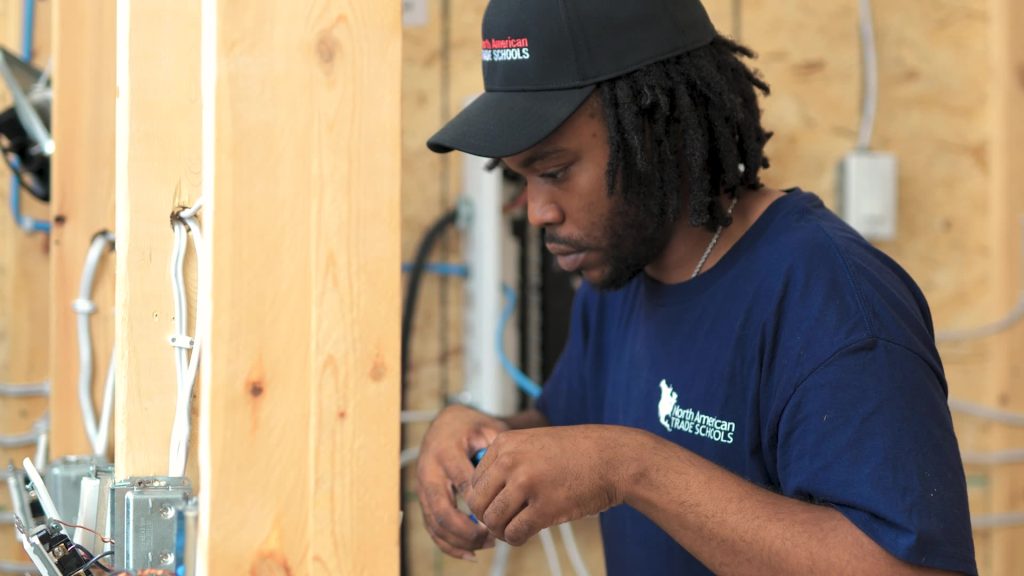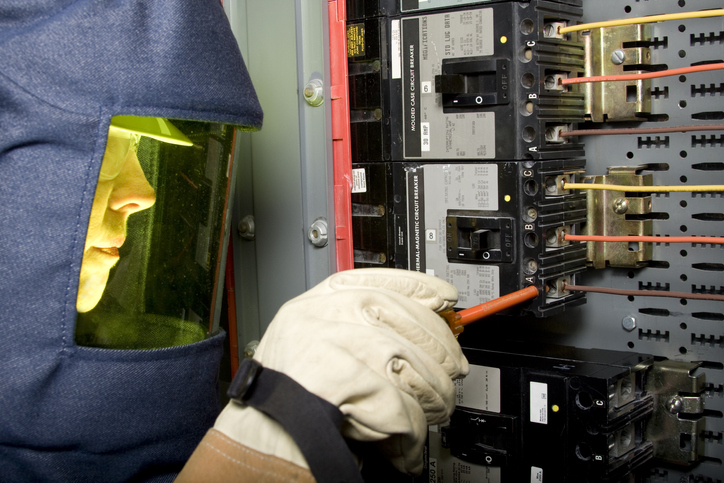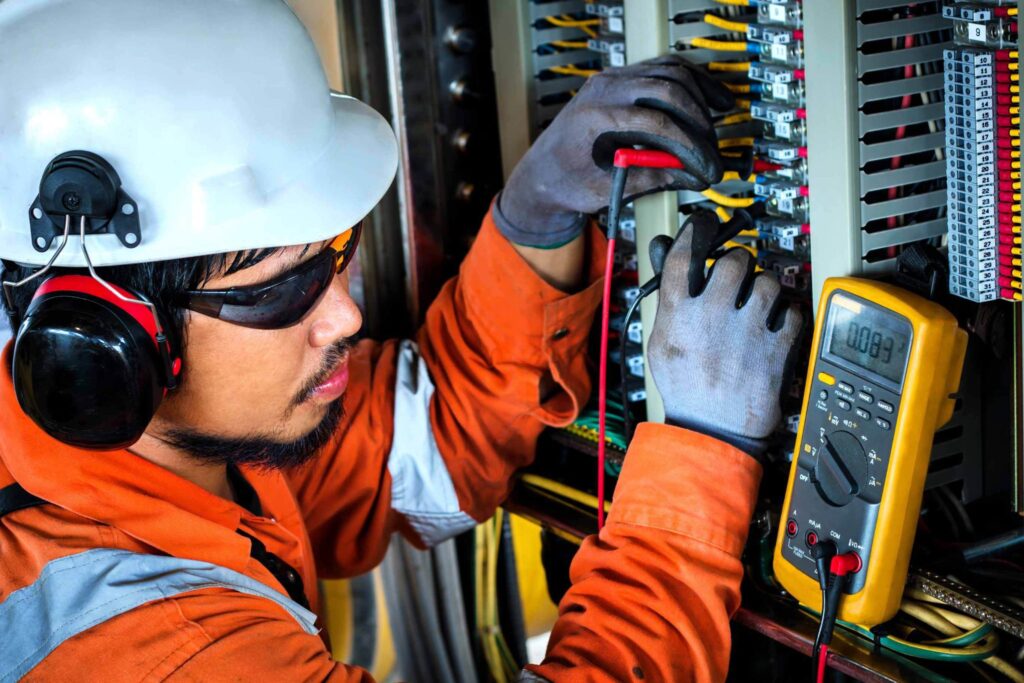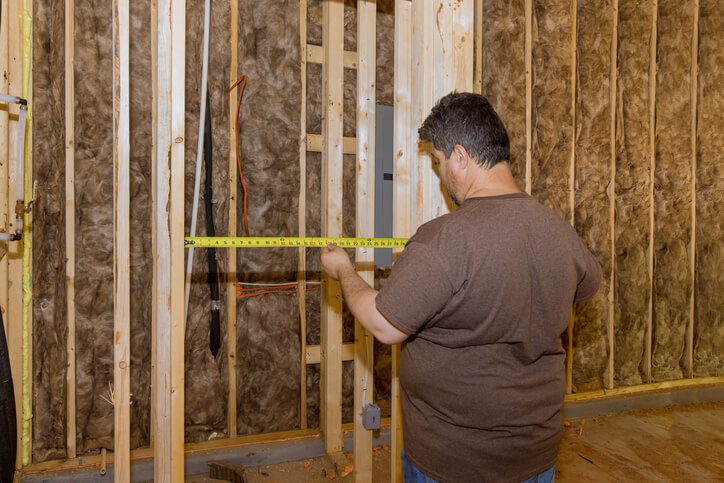Category: Construction Maintenance Electrician
How to Start Electrician Certification in London Today
November 05, 2025If you live in London and you’re thinking about starting a career in the trades, electrician certification might be a strong first step. Not only is this type of work steady and rewarding, it’s in demand across residential, commercial, and industrial sites. The best part is there’s a clear path to begin your training locally, especially as students get ready for spring job openings.
Electrician training in London starts with hands-on classroom experience and can lead into apprenticeships that prepare you for full certification. Whether you’re finishing high school, changing careers, or newly settled in Canada, getting trained as an electrician could lead to dependable work in your own community. Let’s cover what certification involves, what you’ll learn, and how to get started with training this fall.
What Certification Means for Future Electricians
In Ontario, becoming a certified construction maintenance electrician means following a structured training path. Most people begin with a college program that introduces them to the industry, covers key safety practices, and sets up the basics for an apprenticeship.
The apprenticeship is a critical step, blending work in the field with more classroom learning. You work alongside experienced professionals as you build your skills. Over time, you prepare for your Certificate of Qualification, which opens up full-time opportunities where you can work on your own or with a crew.
Once certified, electricians find work in homes, offices, factories, or public buildings. These skills travel with you. Whether you stay local or move to another part of Ontario, the certificate gives you flexibility and opens doors for long-term employment, including the possibility of running your own small business.
What You’ll Learn in Electrician Training
Electrician training focuses on real work skills and safety. Students start with basics like installing circuits, reading blueprints, and learning proper handling of electrical equipment. Classes include hands-on practice wiring outlets, installing switches, and troubleshooting problems you’ll actually see on the job.
Safety is a big part of every lesson. You’ll use test equipment, learn how to work with live power safely, and build up confidence by running through real-life situations under supervision.
Instructors at North American Trade Schools are deeply experienced, often coming from the industry themselves. That means they share stories from actual job sites and show how what you learn in class plays out in the field. Students use current equipment and technology found in modern workplaces, making it easier to transition to employment after graduation.
Why London is a Strong Place to Train
London is a great place to start your training for electrician certification. The city has ongoing construction, frequent renovations, and new builds in both residential and commercial spaces. This keeps a steady demand for people who can wire and repair safely.
Access to a campus in London means you can stay close to home and start networking with local contractors. Real job placements are often found through community connections made while in school.
Timing matters. Fall is a smart time to get started, since companies line up apprentices through the winter, preparing for extra staffing needs once spring projects begin. Training now means you’ll be ready when local employers start hiring again as the weather warms up.
Getting Started: Steps to Begin Training This Fall
Starting your electrician certification in London begins with applying to a local career college or program. You’ll join a group of students learning the ropes, mixing classroom discussion with shop or lab exercises. From day one, you get familiar with the basics—circuit wiring, code requirements, and using diagnostic tools under careful instruction.
The curriculum is organized to help new students, not just those with past experience. Anyone willing to learn and work with their hands can do well.
To see what a local program can offer, look at the Construction Maintenance Electrician courses offered in London. They show the mix of subjects and projects that build your skill week by week.
Starting your studies in the fall puts you ahead for spring hiring cycles and might make landing an apprenticeship or placement that much easier.
What Comes Next After Your Certification
Completing your training and putting in all the required hours lets you write your certification exam. Once you pass that, you’re ready to work for yourself or as part of a licensed team.
Most new grads begin as apprentices or assistants, helping out on various jobs and picking up skills by doing. With more time, you could branch into speciality work, take on supervisor duties, or move toward contract work on larger sites.
Workers who build trust and show they understand safety, code compliance, and quality get noticed and can move up faster within a crew or company.
A Career Path You Can Count On
Starting the path to electrician certification in London is a smart step toward a hands-on, respected job with steady income. The training blends the latest equipment and experienced instructors, making it easier to handle local work.
Getting started now sets you up for spring jobs, giving you a head start before the main hiring rush. Training at a local, career-focused school connects you to employers, classmates, and mentors who want to see you succeed. Each lesson, tool demonstration, and troubleshooting practice brings you closer to a long-lasting skilled trade that will stay in demand for years to come.
Ready to turn your interest in electrical work into hands-on skills? With local training, experienced instructors, and clear steps toward job readiness, you’re closer than you think. Our program is built to help you build confidence, get practical experience, and start strong. See what’s included in electrician certification in London and how it connects to real opportunities. Contact North American Trade Schools to talk with someone who can help you take the next step.
Learn More About Construction Trades Training in Brampton
October 22, 2025Right now, many people across Brampton are thinking differently about their careers. Whether they’re just out of high school or looking for something more hands-on after working in another field, skilled trades have become a real option. When we talk to people who are curious about careers with steady hours and practical tasks, construction often comes up. That’s not surprising since residential and commercial building projects are active across the region, and trained workers are needed more than ever.
Construction trades training in Brampton is one way people are preparing for those jobs. The learning is hands-on from the start and built around the kind of tasks students will actually face on the job. Training like this doesn’t just give a general overview of the field. It breaks down the work piece by piece so students feel ready when it’s time to get started on their first site.
We’ll look at some of those parts—what skills are built, what it’s like to train here in Brampton, and how the seasons can affect your job timeline. If you’ve ever thought about learning a trade that gets you moving and building, now might be the time to take a closer look.
What You’ll Learn in a Construction Trades Program
Construction trades training isn’t about sitting at a desk taking notes all day. Most of what’s taught happens through real tasks and repetition. That means using tools, studying drawings, and building actual parts of structures in a lab-based environment.
Some of the core skills students develop include:
– Framing walls and supports using wood and basic layout tools
– Hanging drywall and prepping surfaces for finishing
– Using common power tools safely and properly
– Reading blueprints and understanding instructions before starting a task
– Following jobsite safety rules and knowing when to ask for help
These tasks form the backbone of how buildings go up or come back together during repairs and renovations. In training, students work on small-scale models or projects that echo actual construction jobs. The scenarios are drawn from the experience of instructors who have spent years in the field.
Safety is part of every step. You learn how to carry tools, lift materials, and stay alert to changing conditions—skills as important as the technical tasks themselves. That is what lets students complete jobs with confidence and avoid injury.
Why Brampton Is a Smart Place to Train
Living and learning in Brampton has some clear advantages for those entering construction trades. The area is full of active developments and renovations, from suburban new builds to upgrades in retail and business zones. That means opportunities are all around, and more are expected as projects start up through next year.
For residents, local training offers short commutes to classes and placements. Early mornings and long days are easier when you are close to home. Being nearby can help students feel more grounded as they start building their career.
Local programs often connect students with employers through job site visits or guest talks. Meeting company reps and touring work sites while still in training can lead to job leads, advice, and even placements right after graduation. This early exposure to the local scene is a real advantage for job seekers.
Career Options After Graduation
Graduates of construction trades training in Brampton do not have to wait long to put their new skills to use. Most start with entry-level work such as:
– General labourer
– Drywall installer
– Renovation helper
– Framer’s assistant
These jobs are a great match for recent grads, letting them apply in-class learning while staying supported by experienced supervisors. The real draw is growth. Over time, new hires gain enough experience to move into more focused jobs—finishing, trim, site coordination, or project support.
With dedication, you might advance to roles such as lead hand or supervisor, running projects or managing teams on both residential and commercial builds. Training gives you a foundation with the flexibility to move in the direction that most interests you.
It’s helpful that NATS instructors and program advisors keep in touch with Brampton employers, so they know exactly what is in demand and adjust content as needed. This focus helps grads stand out to hiring teams.
What Makes NATS Training Different
Every trades program is a bit different, but the NATS approach stands out by closely matching classes to local jobs. Projects are based on tasks you’ll see in Brampton’s busy construction scene, not random theory. Whether you’re framing, wiring, or running installation drills, the work is based on the region’s needs.
Instructors with field experience guide lessons, drawing on their own time in construction to show what really happens on a site. Instead of talking only from textbooks, they offer tips, show real mistakes, and help students avoid common slip-ups on the job.
NATS shop space gives students hands-on practice with industry-standard tools and equipment. Learning to use the same power tools, saws, ladders, and panels found on Brampton job sites means the gap between classroom and real work gets smaller.
How the Seasons Affect Construction Careers
Fall is a good season to think about starting construction trades training in Brampton. Some outdoor jobs slow with winter, but many projects move inside—especially in renovations, commercial interiors, and multi-phase residential builds. Students who start in the fall get time in labs and classrooms to master skills before spring, when outdoor and large-scale hiring picks up again.
Learning during the cooler months means you enter prime hiring season with well-practised skills. Construction keeps going even in winter, focusing on inside work, prep, and finishing jobs so sites keep moving. Being ready at the right time helps jobseekers get first pick among employers starting new projects.
Get Job-Ready Skills You Can Build On
Training for construction trades in Brampton is more than earning a certificate—it’s the start of a real career built on active skills, day-to-day confidence, and local job contacts. The work taught in training matches what area employers want right now, helping students step straight into their first jobs.
For people ready to get moving and start making a mark, learning the basics of a construction trade is a strong step. As Brampton stays busy with new builds and renovations, the skills learned now can lead to even more opportunities when hiring ramps up in the spring. The season is right for anyone ready to build a steady future.
Thinking about starting a career in the trades and living in or near Brampton? This is a great time to take that first step. Training that focuses on real job-site tasks—like framing, tool handling, and blueprint reading—can build the confidence to get started with purpose. Our program in construction trades training in Brampton blends hands-on learning with practical classroom time, giving you the right mix to prepare for the field. At North American Trade Schools, we’re here to help you build skills that work in the real world. Let’s talk about how you can move forward today.
Starting a Future in Construction Trades in London
October 15, 2025If you’re thinking about what comes next after high school or considering a new direction in life, training for work in the construction trades in London can be a solid option. Construction jobs offer steady work, practical skills, and room to grow, and here in London, projects are happening all the time. From new housing developments to renovations and storefront upgrades, skilled tradespeople are in demand.
If you’ve ever looked around and thought, “I want a job where I can work with my hands and see what I’ve done at the end of the day,” this could be your path. We’ll walk through what construction looks like in London, what kind of training helps you get started, and the types of jobs that open up after your training is done.
What Construction Work Looks Like in London
Building and renovation projects stretch across neighbourhoods in London. Some areas are adding new homes, while others are focused on repairs or upgrades to older buildings. You’ll find work sites tucked into residential streets and commercial zones. As fall rolls into winter, the type of work shifts. Outside jobs wrap up and more companies turn to indoor renovations or weather prep.
Seasonal work comes with its own pace. Late fall often brings in projects that focus on insulation, drywall, or flooring before the cold sets in. Local crews stay busy getting stores ready for winter shopping or helping homeowners finish upgrades before the holidays. At these times, site managers look for people who can step into entry-level roles, handle tools safely, and keep jobs moving.
That’s where hands-on skills matter. Even if you’ve never been on a site before, companies often prefer to hire people who already know how to work safely and follow the flow of a build. That kind of prep usually comes from doing real work in a training setting where you’ve handled the tools and followed a project plan, not just read about it.
What You’ll Learn in Construction Trades Training
When students start out, most haven’t used power tools or worked on a team to complete a renovation. That’s why structured training helps. In a construction trades program, students get the basics and then move straight into hands-on tasks. You learn how to measure properly, use tools like drills and saws, follow safety steps, and understand how jobs get planned and finished.
If you’re curious about electrical work or full renovations, you might look at programs like Construction and Maintenance Electrician or Home Renovation Technician at North American Trade Schools. These training options include classroom lessons paired with shop time and physical practice. They cover safe wiring, framing, flooring, and drywall installation, depending on your focus. The Home Renovation Technician program even includes real build projects that let you practise from start to finish.
What makes this kind of learning different is that there’s no guessing. You’re taught what each job calls for and how to do it properly. By the time you reach a real work site, you’ve already built your confidence step by step. You might not know every tool on day one, but you’ll know how to work safely, how to ask good questions, and how to get started without slowing the crew down.
Jobs You Can Step Into After Graduation
After finishing a training program, there are several types of jobs where people get their start. You might begin as a general labourer, where you help more experienced tradespeople on site and take care of tasks like cleanup, loading materials, and basic setups. Some students step into a role as an electrician’s apprentice, which is a good choice if you’re planning to move into the electrical trade over time. Other entry points include working on home renovations or joining a property maintenance team.
The nice part is that each role teaches you something new. With steady hours and more time spent on tools, you pick up confidence, speed, and problem-solving habits. That’s how people move from support roles into positions like lead hand, site helper, or eventually foreman.
It makes sense to think about timing too. Fall training puts you in a good spot because many job sites shift into indoor work just as your classes wrap up. Company owners often want extra help during busier winter months, especially if they’ve got backlogged work or new contracts set to start after the holidays.
Why Fall Is a Smart Time to Get Started
Fall isn’t just about cooler temperatures and leaves on the ground. It’s the season when job sites get more focused, tradespeople shift indoors, and many companies start planning their winter jobs. Whether it’s a store renovation or converting parts of a home, the work usually picks up in late November and runs through the winter.
If you’re starting construction trades training in London during the fall, it means you’ll likely be ready to work just as that winter wave begins. Whether that’s in early December or just after New Year’s, it helps if you’ve already learned how to grab materials, measure correctly, and finish tasks without needing constant guidance.
The other benefit is location. In London, there are plenty of job sites you can reach without leaving the city. Crews work in established neighbourhoods, on city upgrades, and in new developments. Being close makes it easier to try for work as soon as hiring starts, without needing cross-province travel or overnight stays.
Building More Than a Job—Starting a Career That Lasts
Construction work isn’t just hard labour. It’s focused, hands-on, and gives a clear sense of progress. At the end of the day, you can see what got finished. That part sticks with people. Not everyone wants to sit at a desk, and construction gives a clear route for people who prefer physical work, steady routines, and a team-focused environment.
Here in London, there’s a growing need for people who want to start small and stick with it. Training for the trades teaches more than just tool skills. It builds habits and teaches you how to be on time, follow directions, work as part of a group, and stand behind what you’ve built.
A job becomes a career when your skills turn into habits, and each new step opens another opportunity. With the right prep and a willingness to show what you can do, construction trades in London offer a way to start strong and grow from there. If you’re ready to get moving, fall is a good time to begin that first step.
Getting into trades means learning by doing, and that’s exactly how we train. If you’re interested in starting with construction trades in London, our programs offer practical, hands-on experience that connects directly to jobs across the region. You’ll build the skills real employers need and get the support to keep moving forward. At North American Trade Schools, we’re here to help you take that next step with confidence. Contact us today to get started.
A Guide to A Rewarding Career in the Trades

Are you interested in becoming an electrician? The Construction & Maintenance Electrician Pre-Apprenticeship Program at North American Trade Schools (NATS) in Ontario can help you get started. This program teaches the skills you need to work in residential, commercial, and industrial electrical jobs.
What You’ll Learn
At NATS, students get both classroom instruction and hands-on training to prepare for real-world electrical work. Some of the key topics covered include:
- Residential Wiring – Learn how to install and maintain electrical systems in houses.
- Electrical Motor Theory – Understand how electric motors work and where they’re used.
- Equipment Installation & Maintenance – Gain skills in setting up and repairing electrical equipment.
- Programmable Logic Controls (PLCs) – Study the basics of automation, which is important in modern industries.
- Electrical Code & Safety – Learn the laws and safety rules electricians must follow.
By the end of the program, students will have the knowledge and experience needed to take the next step toward becoming a licensed electrician.

Job Opportunities
After finishing this program, graduates can find jobs in different electrical fields, such as:
- Electrical Control Assembler – Work with control panels and electrical systems.
- Electrical Technician – Install and repair electrical systems in homes and businesses.
- Electrical Service Technician – Troubleshoot and maintain electrical equipment.
- Electrical Distribution Apprentice – Help set up and maintain electrical power systems.
Electricians are in high demand and this makes it a great career choice for those who enjoy hands-on work and problem-solving.
The Path to Becoming an Electrician
According to Skilled Trades Ontario, electricians must complete a 9,000 hour apprenticeship to get licensed. This includes:
- 8,160 hours of on-the-job training
- 840 hours of in-school instruction
This process takes about five years and the pre-apprenticeship program at NATS gives students a strong foundation and makes it easier to get an apprenticeship.
Financial Help for Students
Paying for school can be challenging, but there are financial assistance options available:
- Better Jobs Ontario – This Ontario government program helps people switch careers by covering up to $28,000 for tuition, books, and living costs.
- Ontario Student Assistance Program (OSAP) – Offers student loans and grants to those who qualify.
These programs make it easier for students to start a trade career without worrying about high costs.
Why Choose North American Trade Schools?
NATS has a strong reputation for training students in hands-on careers. We focus on real-world skills, so graduates are ready to work immediately. With locations in Brampton, Burlington, and London, Ontario, students can find a campus that works for them.
Start Your Journey Today
The Construction & Maintenance Electrician Pre-Apprenticeship Program at NATS is a great way to start a high-paying and in-demand career. If you’re ready to take the first step toward becoming an electrician, please fill out our contact form or schedule an appointment online.
Could You Be a Good Foreman After Completing a Construction & Maintenance Electrician Pre-apprenticeship Diploma Program?
January 15, 2024
The career path from a pre-apprenticeship diploma program in Construction and Maintenance Electrician to becoming a foreman is well-trodden. Pre-apprenticeship programs in Canada are essential precursors to diverse careers in the trades. However, this raises an essential question for those looking to explore new career horizons: “Can completing such a program prepare you to be a good foreman?”
Completing a pre-apprenticeship diploma program is a significant first step in becoming a foreman. It provides the technical groundwork necessary for this career. This blog post explores whether completing a Construction and Maintenance Electrician Pre-apprenticeship diploma program helps you become a good foreman.
Understanding the Role of a Foreman
A foreman in the electrical field is much more than just a skilled electrician. They are leaders, planners, and communicators. Foremen are responsible for overseeing the execution of electrical projects, managing teams, ensuring safety compliance, and liaising with other construction professionals. As our electrician courses highlight, this role requires a blend of technical knowledge, leadership skills, and practical experience.

How a Pre-apprenticeship Diploma Program Prepares You for the Role of a Foreman
Gaining Experience: Transitioning from an apprentice to a foreman requires significant field experience. You’ll need to work on various projects, understand electrical systems, and face real-world challenges. This experience is crucial in developing problem-solving skills and practical knowledge.
Developing Leadership Skills: Foremanship is as much about leading people as it is about managing electrical projects. Leadership training, either through additional courses or on-the-job learning, is vital. You need to be adept at motivating teams, resolving conflicts, and communicating effectively, and a pre-apprenticeship diploma program allows you to develop these skills through hands-on training projects.
Understanding Project Management: A foreman needs a good grasp of project management principles. This includes scheduling, budgeting, and resource allocation. A pre-apprenticeship diploma program will introduce these concepts and allow you to master them through further education or mentoring.
Staying Updated with Technology and Codes: The electrical field is continuously evolving. A good foreman stays updated with the latest technologies, tools, and code changes. Continuous learning is a part of the job, and electrician training programs can help develop your love for learning.

Safety First: Foremen are responsible for the safety of their team. A deep understanding of safety protocols and the ability to enforce them is non-negotiable. Pre-apprenticeship programs can introduce you to safety regulations and equip you with the knowledge to ensure full compliance.
How Our Electrician Pre-apprenticeship Prepares You for a Foreman Career
The Construction & Maintenance Electrician Pre-Apprenticeship Diploma Program at NATS offers a well-rounded foundation for aspiring foremen. In our classrooms, students are well-equipped to learn vital skills like residential wiring, service installation, code interpretation, conduit bending, and print reading. Our labs provide hands-on experience in residential, commercial, and industrial electricity, focusing on practical skills such as analyzing and repairing machine controls, electronic controls, and electrical motor theory.
This comprehensive training, which blends theoretical knowledge with practical application, prepares graduates for the multifaceted challenges of a foreman role, ensuring they possess the technical expertise and problem-solving abilities essential in the electrical construction and maintenance industry.
Are you interested in our electrician pre-apprenticeship?
Contact NATS for more information.
4 Reasons To Take Electrician Training In 2024
December 12, 2023
The demand for skilled electricians is rising in an era dominated by technological advancements and a growing emphasis on sustainability. As we enter 2024, the need for professionals in the electrical trade is more significant than ever. If you’re contemplating a career change or looking for clarity about your possible future path, here are four compelling reasons why taking electrician training in 2024 might be your ticket to a rewarding and in-demand profession.
1. Step Into a Thriving Job Market
The digital age has brought about a surge in reliance on technology, leading to an increased demand for electricity. As our homes, businesses, and industries become more dependent on electronic devices, the need for skilled electricians is skyrocketing. From installing wiring in new constructions to repairing and maintaining existing electrical systems, electricians play a crucial role in keeping the lights on. Job Bank Canada projects a positive industrial outlook for electricians in the country, making it a promising field for those seeking stable and well-paying employment.
Beyond this, jobs do not come much more future-proof than electricians’. As technology advances, there’s a lot of buzz around robots taking over jobs, whether on the assembly line or in the office. But you know what? Electricians don’t need to stress about it. Their work is all about adapting to the specific situation or problem at hand, and that’s something robots can’t quite master yet.

Amid all the automation concerns in different industries, electricians have a unique situation. Their job requires a personal touch, a level of quality work that robots just can’t match. It’s not a one-size-fits-all kind of gig; it’s about tailoring their skills to the job. So, while the talk about AI and robots taking jobs might make some industries uneasy, electricians can rest easy knowing that their expertise and knack for personalized solutions keep them irreplaceable.
2. Embrace Green Technology Through Electrician Training
There has been a significant shift towards sustainable and eco-friendly practices in recent years. The electrician’s role is evolving to accommodate this change. Renewable energy sources, such as solar and wind power, are gaining momentum, and electricians training in green technology are in high demand.
By enrolling in pre-apprenticeship electrical training in 2024, you position yourself at the forefront of this shift, learning to install and maintain solar panels, and other green energy systems. This opens up new career opportunities and allows you to contribute to a more sustainable future.

3. Integrate Automation and Smart Technology Into Your Work Life
The rise of smart homes and automated systems transforms our lives and work. Electricians with expertise in innovative technology are becoming increasingly sought after. From installing smart lighting and security systems to configuring home automation hubs, the modern electrician is a tech-savvy professional.
By taking electrician courses, you equip yourself with the knowledge and skills to integrate innovative technology into residential and commercial spaces. This expertise positions you as a valuable asset in an industry rapidly embracing automation.
4. Opportunities for Job Diversity and Independence
One of the most appealing aspects of a career as an electrician is the diversity of job opportunities and the potential for independence. Electricians can work in various residential, commercial, and industrial settings. Additionally, many electricians eventually opt for self-employment, running their businesses.
Electrician training provides a versatile skill set that allows you to adapt to different work environments and pursue entrepreneurial ventures. The ability to take on a range of projects and the potential for self-employment offer flexibility and independence that few other professions can match.
Are you interested in our world-class Pre-Apprentice Electrical diploma?
Contact NATS for more information.
Residential, Commercial, Or Industrial: Which Path Will You Take After Electrician Training?
June 22, 2023
Many people who enrol in the Construction Maintenance Electrician Diploma Program at North American Trade Schools (NATS) already have a clear idea of where they would like to work before they even register for the program. Conversely, some others prefer to go with the flow and see what piques their interest along the way.
Irrespective of which side of the spectrum you fall in, the question of which path you’ll take after electrician training is an important one since there are typically differences between residential, commercial, and industrial electricians.
Ultimately, the decision should come down to which career path best suits your interests and career goals. To help narrow your focus leading to an informed decision, we’ll explore each of these career paths in this blog.
Residential Work After Electrician Training
Residential electrical work focuses on homes, apartments, and other residential properties. On a typical day as a residential electrician after your Electrician training, you’ll be responsible for installing, repairing, and maintaining electrical systems in these settings. This often involves tasks like wiring new homes, troubleshooting electrical issues, or upgrading outdated systems. One of the advantages of working in the residential sector is the opportunity to work directly with homeowners, helping them improve their living spaces and ensuring their electrical systems are safe and efficient. Residential work also offers more regular working hours, allowing for a better work-life balance.
Commercial Work After Electrician Training
On the other hand, commercial electricians deal with electrical systems in non-residential buildings such as offices, retail stores, and public facilities. Commercial work often involves large-scale projects, such as installing electrical systems in new commercial buildings or upgrading existing systems to meet code requirements. Typically, commercial electricians execute tasks like setting up lighting systems, installing security systems, or performing routine maintenance. Commercial work can be fast-paced and diverse, providing opportunities to work on a wide range of projects and collaborate with other professionals in the construction industry.

Industrial Work After Electrician Training
Industrial electrical work takes you into the realm of factories, power plants, and other industrial settings. In this sector, you’ll work with complex electrical systems that power heavy machinery, production lines, and industrial processes. Industrial electricians often use high-voltage systems, motors, control panels, and automation technologies. This type of work requires a strong understanding of industrial equipment and safety protocols. Industrial electricians may troubleshoot electrical issues under time pressure to minimize downtime and keep production running smoothly. Working in the industrial sector can be challenging but highly rewarding, with opportunities for career advancement and specialized training.

Which Path is Right For You?
When deciding which path to take after electrician training, it’s important to consider your personal interests, skills, and long-term goals. Do you enjoy working in various settings or prefer the stability of residential work? Are you intrigued by the complexity of industrial electrical systems or drawn to the fast-paced nature of commercial projects? It’s also worth noting that you can start in one sector and transition to another later in your career. Many electricians gain experience in one area before exploring new opportunities. Regardless of your chosen path, ongoing learning and professional development are essential.
If you’re interested in obtaining a more detailed understanding of each of these paths and the processes associated with them, consider registering for the Construction and Maintenance Electrician diploma Program at NATS.
Are you ready to start training toward your career at an Electrician college?
Contact NATS to learn how you can get started!
3 Rough-In Tips to Remember After Electrician Training
June 07, 2023
Rough-in wiring involves installing electrical wiring, boxes, and conduit in commercial or residential buildings before the walls and ceilings are completed. It’s a necessary process that sets the foundation for a safe and efficient electrical system in any building.
Regardless of the type of project being executed, it’s important to get the rough-in phase done right the first time. Ripping up the drywall to fix issues down the line can be messy, not to mention expensive. It’s also essential to be careful with this task to avoid the risk of electric and fire hazards. Attention to detail and adherence to electrical codes are necessary for a high-quality installation.
After completing your Construction & Maintenance Electrician Pre-Apprenticeship diploma program, you’ll often be tasked with projects like these. Here, we’ll discuss three practical rough-in tips that will prove invaluable throughout your career. Incorporating these tips into your work routine after completing electrician training will help you build a reputation for excellence and contribute to electrical systems’ safe and efficient operation.
1. Plan and Prepare Adequately After Electrician College
Before starting any rough-in work, careful planning is crucial. Begin by reviewing the electrical plans and blueprints for the building to understand the project scope clearly. Take note of the locations for outlets, switches, light fixtures, and other electrical components.
Next, ensure you have all the tools and materials readily available. This includes wires, cables, conduits, junction boxes, and fasteners. Organize your supplies to avoid unnecessary delays during the installation process.
Additionally, before commencing any rough-in work, shut off the power supply to the area where you will be working. As taught in Electrician training, safety should always be the top priority. Taking this precautionary measure will prevent accidents or electrical shocks.
2. Get Accurate Measurements and Layouts
During the rough-in phase, precision is essential. Accurate measurements and layouts ensure that electrical components are installed correctly, avoiding future problems or the need for costly rework. Students who undergo their Electrician diploma program know this process is often emphasized during their training.

Mark the locations of electrical boxes on the walls and ceilings according to the provided blueprints, then use a tape measure and level to ensure the measurements are precise. Consider any obstructions, such as studs or pipes that may affect the placement of the boxes. Similarly, when running conduit or cables, maintain consistent spacing and alignment. This will facilitate future wire-pulling and make identifying and troubleshooting issues easier if necessary.
Further, pay close attention to electrical code requirements, including minimum clearance distances around boxes and conduits, and remember compliance with electrical codes is crucial for safety and ensures the installation meets industry standards.
3. Label and Document Each Step
The rough-in phase is the foundation for the entire electrical system, and documenting your work is invaluable for future reference. As you install wires, cables, and conduits, take the time to label them appropriately by using tags or markers to indicate the purpose and destination of each cable or wire. This makes it easier for future electricians or technicians to identify and troubleshoot issues.

You should also create a comprehensive documentation system that includes diagrams, plans, and any modifications made during the rough-in process. This information will be invaluable for future maintenance, repairs, or upgrades. Remember to photograph the rough-in work before the walls and ceilings are closed. These photos can provide evidence of a job well done and a visual reference if needed.
Are you looking to join a world-class Electrician college?
Contact NATS to learn how to get started.
Networking Tips For An Apprentice After Electrician Training
February 28, 2023
Networking is important no matter which industry you are in, because it allows you to form mutually beneficial relationships with other professionals in your field. Once you become an apprentice after electrician training, you’ll be looking to grow in the trade – honing your skills and gaining access to professional opportunities. Networking is a great way to meet and stay in touch with seasoned industry experts and those just starting out like you. Having a broad network can open many doors for you professionally, helping you stay on top of new opportunities.
Read on for some great networking tips to keep in mind during your training and throughout your career.
Partake in Industry Events and Conferences
Industry events and conferences are great ways to network with people in your industry. While larger conferences do not necessarily happen often, it is important to attend them because you will have the opportunity to learn from and discuss with other electricians and apprentices, and create beneficial relationships.
A great way to learn about these conferences and events is either online or through your instructors during your Electrician diploma. Your instructors are experienced in the industry and have already built their network over several years. They are great starting points for discovering these events and conferences. Online, you will find many different events, and the beauty of these is that they occur digitally and can be attended no matter where you are.

Use Social Media to the Fullest Extent
Social media is a great networking tool that you can utilize at any point, and it will be beneficial for years to come. There are two primary social media networks you should be using to network during and after Electrician training – these are LinkedIn and Facebook. LinkedIn is great for forming connections with qualified electricians or apprentices. You never know when someone who you interacted with on social media may be able to present an opportunity to you, and vice versa. A great starting point is your instructors and fellow apprentices.
Facebook is a little different in that it would be more advisable to join a local electrician group instead of adding people as friends. This allows you to interact with people in the same career as you and enables knowledge sharing. There may also be opportunities for apprentice electricians posted on these groups. The key is to maintain consistent contact. Speak to instructors and fellow apprentices about electrician groups, otherwise, a Facebook search can also put you in the right direction.

Keep in Contact With People You Meet in Electrician Training
During electrician training, you will interact with your instructors and classmates, so try to develop relationships that will help you to expand your network. Keep in contact with them after you have completed your training, because your instructors can introduce you to people in the industry, since they’re extremely knowledgeable and have contacts there. Your peers may also find other opportunities that they can share with you. It takes time and effort, but having a great network will reap its benefits in the longrun.
Are you ready to begin Electrician college?
Contact NATS to learn how you can get started.
Interesting Career Paths to Explore After Construction College
January 25, 2023
The construction industry consists of individuals with varying skills. All of these skilled workers play a role in making sure that construction projects meet the specifications outlined in their planning. A good construction program will prepare you to meet the needs of the industry, helping you thrive in your career.
During the construction program at NATS, you will learn the skills to fulfil several electrical industry aspects successfully. You will also learn residential wiring, code interpretation, conduit bending, electrical motor theory, service installation, print reading, and electronic controls. These are skills you can apply to various career paths upon completing the program. Read on to learn more about the careers that will be available to you after your training.
Become an Electrical Technician
An electrical technician is a skilled worker that focuses on installing wiring, ensuring that the wiring works correctly, and installing circuits and outlets to power electronics, lights and other equipment in a building. Professionals in this career will need to be able to read electrical blueprints and follow electrical codes and regulations. During construction training, you will learn these skills through practical, hands-on training. For instance, you’ll complete practical, real-world projects installing wiring similar to what you will see when working as an electrical technician.
Becoming an electrical technician will create work opportunities for you in both residential and commercial construction. You will also be able to work in a company’s maintenance department and see to the electrical needs of the company as they happen.

Become an Electrical Service Technician After Construction College
As an electrical service technician, you will specialize in ensuring that electrical equipment and systems remain operational and function as they need to. You may be required to modify systems or repair them completely.
During construction college, you will learn different wiring methods for conduits, tubing and bends. This will help you rewire electrical devices where the wiring has corroded or is no longer functional. You will also learn how to apply the Canadian Electrical Code (CEC), ensuring that repairs and rewiring are done to the standard required.
Become an Electrician by Continuing Your Apprenticeship
As a graduate earning your Construction and Maintenance Electrician Diploma, you will be an apprentice electrician. This will allow you to continue studying the electrical trade to become a qualified electrician. While becoming a qualified electrician may be longer, it is worth considering. This is primarily due to the demand for qualified electricians in Canada. Job prospects for electricians in Canada are good and look to remain this way for years to come. Becoming a fully qualified electrician will also open other opportunities, including starting your own business.
The training you receive during your diploma program will equip you with the foundations of being an electrician. You will learn electrical theory and principles and how to apply them practically. You will also learn the foundations of what an electrician needs to know, such as wiring, the CEC, and safety principles, ensuring you are well-equipped to continue your studies to become a fully-qualified electrician.

Are you ready to begin your construction courses?
Contact NATS to learn how you can get started.





